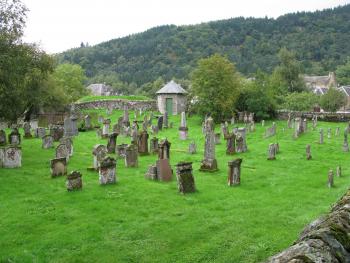- Navigation:
- Back to the Corpus index page
- RSS
Callander Parish Church
Callander Old Churchyard and watch house
- Dedication: unknown/St Kessog
- Diocese of Dunblane
- County of Perthshire
- Stirling Council
- NN 6267 0787
Summary description
Nothing remains of the medieval church, which is assumed to have stood within the churchyard to the west of Bridge Street, on the north bank of the River Teith.
Historical outline
Dedication: unknown/St Kessog(1)
Little is known of the history of this church and parish, which is first mentioned in the thirteenth century. It was one of several churches over which Bishop Clement of Dunblane and Walter Comyn, earl of Menteith, held rival claims, which in 1238 the earl surrendered to the bishop.(2) From that date, the parsonage was united with the episcopal mensa and remained so annexed at the Reformation.(3) The cure appears to have been served by a vicarage perpetual, occurring as such in 1429, and it was held at the Reformation by sir John Wrycht.(4) It appears that Wrycht held the vicarage conjointly with the endowed chaplainry of St Michael in Dunblane Cathedral.(5)
Notes
1. Cockburn, Medieval Bishops of Dunblane, 9.
2. Fraser, Menteith, ii, 326-9.
3. Kirk (ed.), Book of Assumptions, 295, 335, 348.
4. CSSR, iii, 6, 19, 29, 62, 141; Kirk (ed.), Book of Assumptions, 295, 335, 348.
Architectural description
The medieval church is thought to have been within a graveyard on the north bank of the River Teith, to the west of what is now Bridge Street, on the southern side of the town. Nothing survives of any church there, although the use of the graveyard continued after the church had been relocated elsewhere in the town, as is most clearly evident from the construction of a new watchhouse in 1832.
The parish church of Callander has had a complex post-Reformation history. The medieval building was in 1771-3 replaced by a more prominently sited new building, a short distance to the north-east, on the north side of Main Street. That church was in turn replaced by another building on the same site in 1883, which is currently used as a visitor centre. The present parish church is on South Church Street, where it was originally built in 1861 to serve a Free Church congregation.
Bibliography
Calendar of Scottish Supplications to Rome 1428-32, 1970, ed. A.I. Dunlop; and I.B. Cowan, (Scottish History Society) Edinburgh, 6, 19, 29, 42, 141.
Cockburn, J.H., 1959, The Mediaeval Bishops of Dunblane and their Church, Edinburgh, 9.
Cowan, I.B., 1967, The parishes of medieval Scotland, (Scottish Record Society), Edinburgh, 25.
Donaldson, G., 1949, Accounts of the collectors of thirds of benefices, (Scottish History Society), Edinburgh, 15, 165.
Fraser, W., 1880, The Red Book of Menteith, Edinburgh, ii, 326-9.
Gifford, J. and Walker, F.A., 2002, The Buildings of Scotland, Stirling and Central Scotland, New Haven and London, 295.
Kirk, J., 1995, The books of assumption of the thirds of benefices, (British Academy) Oxford, 295, 335, 348.
Mackinlay, J.M., 1914, Ancient church dedications in Scotland, non-scriptural dedications, Edinburgh, 137.
New Statistical Account of Scotland, 1845, Edinburgh and London, x, 358.
Royal Commission on the Ancient and Historical Monuments of Scotland, Canmore database.
Statistical Account of Scotland, 1791-9, ed. J. Sinclair, Edinburgh, xi (1794), 596.
Map
Images
Click on any thumbnail to open the image gallery and slideshow.






